- Care for Adenium Plants
- Light
- Temperature
- Watering
- Soil
- Fertilizer
- Pruning
- Pests and Diseases
- Propagation
- Conclusion
- Beautiful Photos of Adenium
- Different Types of Adenium
- The Ultimate Guide for Adenium Lovers
- Types of Adenium
- Caring for Your Adenium
- Pruning and Propagation
- Pests and Diseases
- Conclusion
- Adenium: A Comprehensive Care Guide
- Introduction
- Light
- Temperature
- Watering
- Soil
- Fertilization
- Pruning
- Pests and Diseases
- Conclusion
- Adenium: Exquisite Photos and Care Tips
- Types of Adenium
- Care Tips for Adenium
- Exquisite Photos of Adenium
- Explore the Various Types of Adenium Plants
- 1. Adenium obesum
- 2. Adenium somalense
- 3. Adenium arabicum
- 4. Adenium swazicum
- 5. Adenium socotranum
- Mastering Adenium Care: The Complete Guide
- 1. Understanding Adenium
- 2. Light Requirements
- 3. Temperature and Humidity
- 4. Watering
- 5. Soil and Potting
- 6. Fertilizing
- 7. Pruning
- 8. Pests and Diseases
- 9. Propagation
- 10. Common Adenium Varieties
- Conclusion
- Q&A
- What is Adenium?
- How do I care for Adenium plants?
- What are the different types of Adenium?
- Can Adenium plants be grown from seeds?
- Do Adenium plants require pruning?
- Are Adenium plants toxic to pets?
- Video 54 Desert Rose (Adenium) Varieties | Desert Rose Flower Types | Adenium Flowers |Plant and Planting
Adenium, also known as desert rose, is a popular plant among gardening enthusiasts for its beautiful flowers and unique desert-like appearance. Native to Africa and the Arabian Peninsula, Adenium is a succulent that thrives in hot and dry climates. With proper care, it can be successfully grown in different parts of the world.
This ultimate guide will provide you with all the information you need to know about taking care of Adenium plants, as well as showcase stunning photos of its various types. Whether you are a beginner or an experienced gardener, this guide will help you enhance your knowledge and skills in growing and maintaining Adenium.
Adenium plants are known for their striking, trumpet-shaped flowers that come in a wide range of colors, including pink, red, white, and yellow. These flowers are an absolute delight to behold and can add a touch of exotic beauty to any garden or indoor space. With the right care and attention, your Adenium plant can produce an abundant display of these stunning flowers.
So, if you are looking to add a touch of desert beauty to your garden or home, or simply want to expand your collection of succulents, this ultimate guide will be your go-to resource for everything Adenium-related. From choosing the right type of plant to providing the ideal growing conditions, this guide will equip you with the knowledge and skills you need to successfully care for and enjoy the beauty of Adenium.
Care for Adenium Plants
Adenium plants, also known as Desert Roses, are beautiful flowering plants that are native to Africa and the Arabian Peninsula. They are widely cultivated for their striking flowers and unique swollen stems. Here are some important tips to help you care for your Adenium plants:
Light
Adenium plants thrive in bright, indirect sunlight. Place your plant near a window where it can receive several hours of sunlight each day. However, be cautious of direct afternoon sunlight, as it can scorch the leaves of the plant.
Temperature
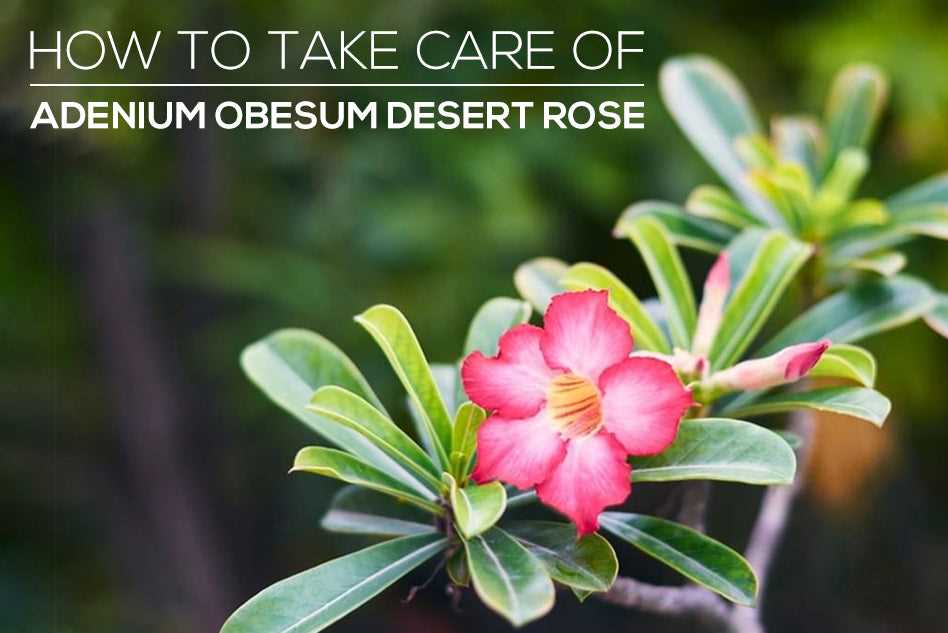
Adenium plants prefer warm temperatures and can tolerate temperatures between 60°F (15°C) and 90°F (32°C). It is important to protect the plant from temperatures below 50°F (10°C) as they can be damaging.
Watering
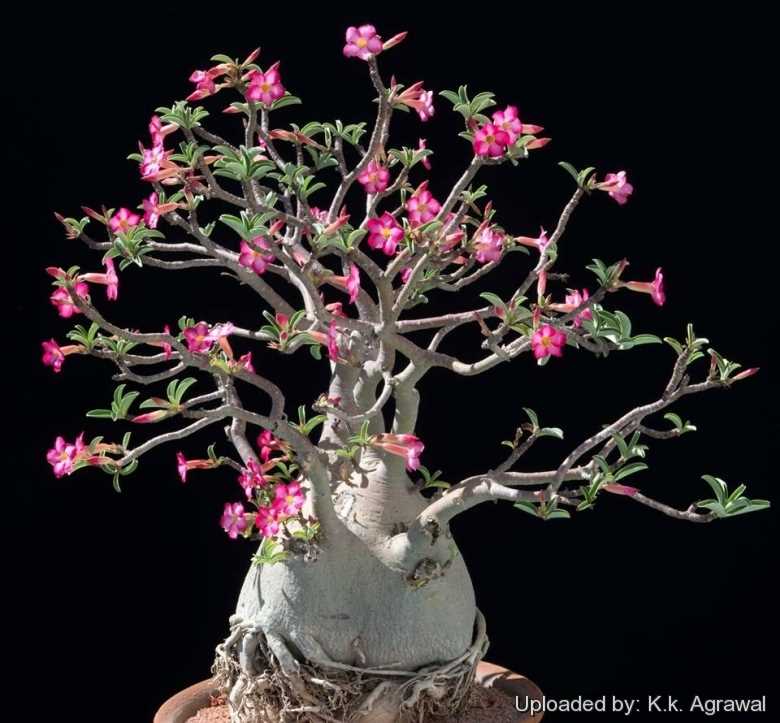
Proper watering is essential for the health of Adenium plants. Water your plant thoroughly when the top inch of soil feels dry to the touch. Be sure to allow the excess water to drain out of the pot, as Adenium plants are susceptible to root rot if they sit in waterlogged soil for too long.
Soil
Adenium plants prefer well-draining soil. Use a cactus or succulent potting mix that provides good drainage to prevent water from pooling around the roots. Adding perlite or sand to the soil can also improve drainage.
Fertilizer
Adenium plants benefit from regular fertilization during their active growing season, which is usually spring and summer. Use a balanced, slow-release fertilizer specifically formulated for succulent plants. Follow the instructions on the fertilizer package for proper application.
Pruning
Pruning is important to maintain the desired shape and size of your Adenium plant. You can prune the plant after the flowering period ends or if it becomes leggy. Use clean and sharp pruning shears to remove any dead or overgrown branches.
Pests and Diseases
Adenium plants can be susceptible to common plant pests such as aphids, spider mites, and mealybugs. Regularly inspect your plants for any signs of pests and treat them promptly with insecticidal soap or horticultural oil. Watch out for signs of root rot, which can occur if the plant is overwatered or if the soil does not provide adequate drainage.
Propagation
Adenium plants can be propagated through stem cuttings or from seeds. Stem cuttings should be taken from the parent plant during the active growing season and allowed to dry for a few days before planting in well-draining soil. Seeds should be planted in a sterile seed-starting mix and kept warm and moist until they germinate.
Conclusion
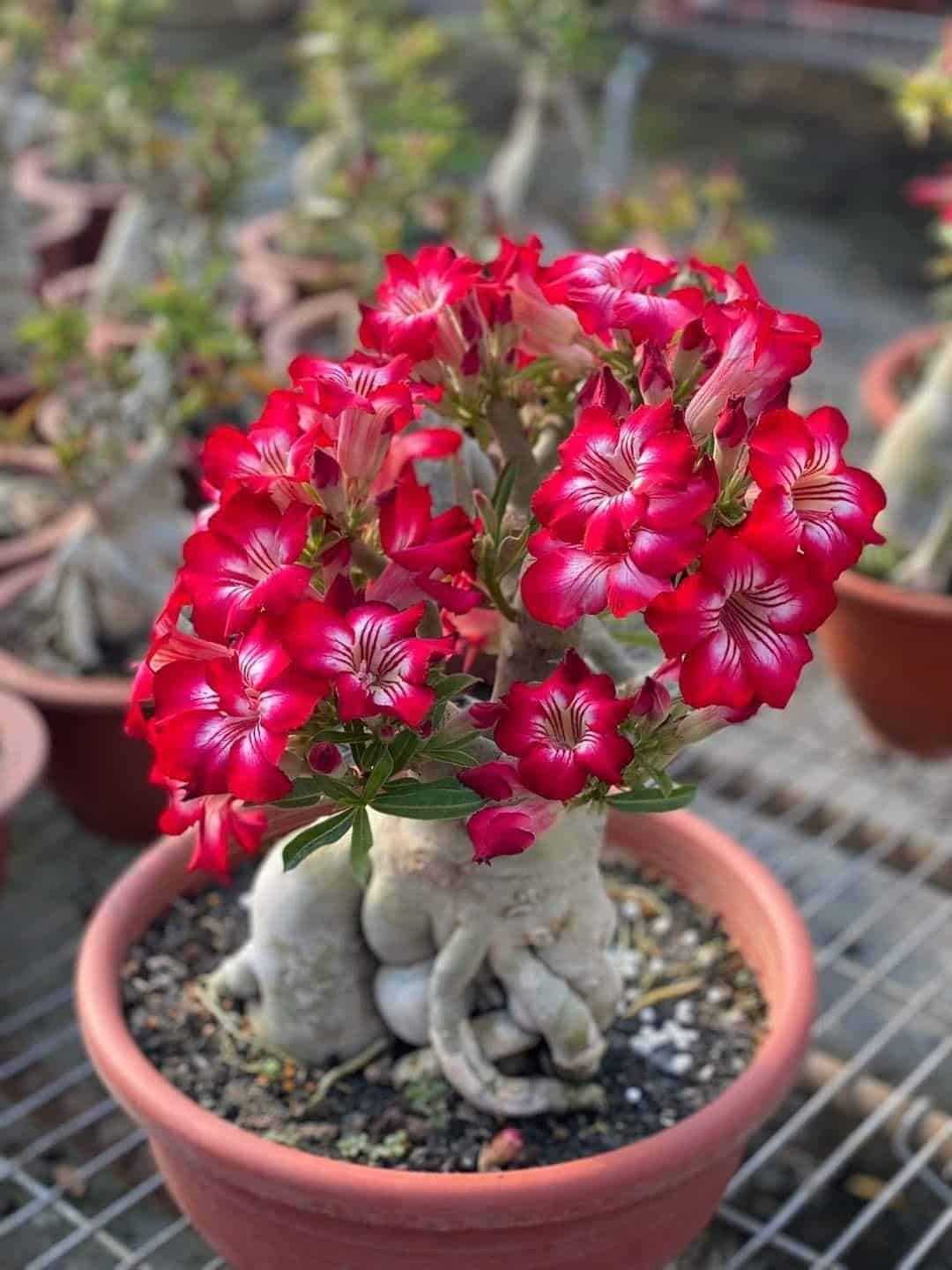
With proper care and attention, your Adenium plants can thrive and produce beautiful flowers for years to come. Remember to provide them with the right amount of light, temperature, water, and nutrients, and they will reward you with their stunning blooms.
Beautiful Photos of Adenium
- Adenium tree with vibrant pink flowers
- Close-up of a blooming Adenium flower with red and white stripes
- Adenium bonsai tree with twisted trunk and bright yellow flowers
- Group of Adenium plants in various colors, including pink, white, and red
- Adenium desert rose with ochre-colored petals
- Adenium seed pods developing after the flowers have faded
- Close-up of Adenium foliage, showcasing its thick, fleshy leaves
- Adenium plant in full bloom, displaying a bouquet of purple flowers
- Adenium with double-flowered variety, featuring multiple layers of petals
- Adenium bonsai showcasing its unique caudex, a swollen stem base
These beautiful photos of Adenium showcase the diversity and magnificence of this unique plant. Whether it’s the vibrant colors of its flowers, the unusual shape of its trunk, or the elegance of its foliage, Adenium is truly a sight to behold.
From the delicate pink petals to the striking yellow blooms, each image captures the essence of Adenium’s beauty. The seed pods and foliage provide a closer look at the different stages of growth and the characteristics that make this succulent so special.
Whether you’re a seasoned Adenium enthusiast or just discovering its wonders, these photos are sure to inspire you to appreciate the splendor of this remarkable plant.
Different Types of Adenium
Adenium, also known as Desert Rose, is a beautiful and exotic plant that comes in a variety of types. Each type of Adenium has its own unique characteristics and features. Here are some of the most common types of Adenium:
- Adenium Obesum: This is the most common type of Adenium and is known for its striking flowers that come in a range of colors such as pink, red, and white. It has a thick, swollen base (caudex) that gives it a unique and dramatic appearance.
- Adenium Arabicum: This type of Adenium has smaller flowers compared to Adenium Obesum. The flowers are usually white or pale pink and have a lighter fragrance. Adenium Arabicum also has a smaller caudex.
- Adenium Somalense: This type of Adenium is native to Africa. It has smaller flowers that come in shades of pink, red, and white. Adenium Somalense has a distinctive caudex that is covered with small, round bumps.
- Adenium Multiflorum: This is a rare type of Adenium that is known for its profuse blooming. It produces clusters of small, tubular flowers in shades of pink, red, and white. Adenium Multiflorum has a smaller caudex compared to other types.
- Adenium Thai Socotranum: This type of Adenium is highly prized for its large flowers that can reach up to 6 inches in diameter. The flowers come in a range of colors such as pink, red, and white. Adenium Thai Socotranum has a medium-sized caudex and is known for its vigorous growth.
These are just a few examples of the different types of Adenium that are available. Each type has its own unique beauty and charm, making Adenium a popular choice among plant enthusiasts.
The Ultimate Guide for Adenium Lovers
Adenium, also known as desert rose, is a popular plant among gardening enthusiasts. With its beautiful flowers and unique growth habits, it has become a favorite for many people. If you are an Adenium lover or thinking of becoming one, this guide is for you. It will provide you with all the information you need to care for your Adenium and keep it happy and healthy.
Types of Adenium
Adeniums come in various types and cultivars, each with its own distinctive features. Some popular types include:
- Obesum: This is the most common and widely available type of Adenium. It has colorful flowers and can be grown as a small tree or a bonsai.
- Somalense: This type of Adenium has thick, twisted branches and tuberous roots. It is known for its unusual form and is often grown as a potted plant.
- Arabicum: Arabicum Adeniums have a more compact growth habit and smaller flowers compared to other types. They are well-suited for small spaces or indoor cultivation.
Caring for Your Adenium
To ensure that your Adenium thrives, it is important to provide it with the right care. Here are some tips:
- Light: Adeniums need plenty of bright, indirect sunlight. Place your plant near a south-facing window or provide it with artificial grow lights.
- Temperature: Adeniums prefer warm temperatures between 65-85°F (18-29°C). Protect them from drafts and cold temperatures.
- Watering: Adeniums are succulent plants and are capable of storing water in their swollen trunk and branches. Water your Adenium thoroughly but allow the soil to dry out between waterings to prevent root rot.
- Soil: Use a well-draining soil mix specifically designed for succulents. A mix of potting soil, perlite, and sand works well for Adeniums.
- Fertilizer: Feed your Adenium with a balanced fertilizer during the growing season. Use a fertilizer formulated for flowering plants and follow the instructions on the packaging.
Pruning and Propagation
Pruning is an important part of Adenium care to maintain its shape and promote healthy growth. Use clean, sharp pruners to remove any dead or damaged branches. You can also propagate Adeniums through stem cuttings. Allow the cuttings to dry for a few days before planting them in a well-draining soil mix.
Pests and Diseases
Adeniums are generally resistant to pests and diseases. However, they can sometimes get infested with mealybugs, spider mites, or aphids. Regularly inspect your plant for any signs of pests and treat them with appropriate insecticides if necessary.
Conclusion
With the right care and attention, your Adenium will reward you with its stunning flowers and unique appearance. Follow the tips and guidelines provided in this ultimate guide to ensure that your Adenium thrives and brings beauty to your indoor or outdoor space.
Adenium: A Comprehensive Care Guide
Introduction
Adenium, also known as desert rose or mock azalea, is a succulent plant native to arid regions of Africa and the Arabian Peninsula. It is loved by many gardeners for its stunning flowers and unique caudex, which gives it an unusual and eye-catching appearance.
Light
Adeniums thrive in full sun conditions, so it’s important to choose a bright spot for your plant. Place it near a south-facing window or in a sunny spot in your garden. If you are growing adeniums indoors, consider using grow lights to provide the necessary light intensity.
Temperature
Adeniums are tropical plants and prefer warm temperatures. They can tolerate temperatures as low as 50°F (10°C), but their ideal temperature range is between 65°F and 85°F (18°C and 29°C). Protect your adenium from frost and cold drafts, as they can cause damage to the plant.
Watering
Adeniums have a unique water-storage system in their caudex, which allows them to withstand periods of drought. However, it’s important to provide them with regular watering during their active growing season. Water the plant thoroughly and allow the soil to dry out slightly before watering again. Be cautious not to overwater, as adeniums are sensitive to root rot.
Soil
Adeniums prefer well-draining soil that replicates their natural habitat. A mix of coarse sand, perlite, and regular potting soil is ideal for adeniums. Avoid heavy or water-retaining soils, as they can lead to root rot and other problems.
Fertilization
During the growing season, adeniums benefit from regular fertilization. Use a balanced, water-soluble fertilizer with a ratio of 10-10-10 or similar. Apply the fertilizer every two weeks, following the instructions on the packaging. Reduce or stop fertilization during the plant’s dormant period.
Pruning
Adeniums can be pruned to maintain their shape and encourage bushy growth. Prune back leggy or overgrown branches in the early spring before new growth begins. Use clean, sharp pruning shears to make clean cuts and avoid damaging the plant.
Pests and Diseases
Adeniums are relatively hardy plants, but they can be susceptible to pests such as mealybugs, aphids, and spider mites. Check your plant regularly for signs of infestation, such as yellowing leaves or sticky residue. Treat infested plants with insecticidal soap or neem oil, following the instructions on the product label.
Conclusion
With proper care and attention, adeniums can thrive and reward you with their beautiful flowers. Remember to provide them with the right amount of light, temperature, water, and nutrients, and monitor them for any signs of pests or diseases. Enjoy the process of growing and caring for these unique plants!
Adenium: Exquisite Photos and Care Tips
Adenium, also known as Desert Rose, is a beautiful flowering succulent plant that is native to Africa and the Arabian Peninsula. With its stunning flowers and unique bonsai-like appearance, Adenium has become a popular choice for plant enthusiasts around the world.
Types of Adenium
There are several types of Adenium that vary in flower shape, size, and color. Some popular types include:
- Obesum: This is the most common and widely cultivated type of Adenium. It has vibrant flowers in shades of pink, red, and white.
- Somalense: This type has large flowers with bright colors and unique patterns.
- Arabicum: Known for its fragrant white flowers, Arabicum is a more compact variety of Adenium.
Care Tips for Adenium
Adenium is a relatively low-maintenance plant, but it does require specific care to thrive. Here are some important care tips to keep in mind:
- Light: Adenium plants prefer bright, indirect sunlight. It’s best to place them near a south-facing window or provide them with 6-8 hours of sunlight per day.
- Temperature: Adenium thrives in warm temperatures between 70-90°F (21-32°C). They are not frost-tolerant, so it’s important to protect them from cold drafts.
- Watering: Adenium plants have a unique watering schedule. They prefer to dry out between waterings, so it’s essential to water them thoroughly and then wait until the soil is dry before watering again.
- Soil: Well-draining soil is crucial for the health of Adenium plants. A mix of sand, perlite, and regular potting soil works well.
- Fertilizer: Adenium plants benefit from a balanced fertilizer formulated for succulents. It’s best to follow the directions on the fertilizer package and fertilize every 2-4 weeks during the growing season.
Exquisite Photos of Adenium
 |  |
 |  |
Adenium plants showcase a variety of stunning colors and flower shapes. Whether you prefer vibrant pinks, deep reds, or elegant whites, there is an Adenium variety for everyone. Explore these exquisite photos to get inspired and discover the beauty of Adenium.
Explore the Various Types of Adenium Plants
Adenium plants, also known as desert roses, are known for their unique appearance and stunning flowers. There are several different types of Adenium, each with its own distinct characteristics. Let’s take a closer look at some of the most popular types:
1. Adenium obesum
Adenium obesum is one of the most common and widely cultivated types of Adenium. It is native to East Africa and is known for its thick, succulent stems and beautiful flowers. The flowers of Adenium obesum come in a variety of colors, including shades of pink, red, purple, and white.
2. Adenium somalense
Adenium somalense is another popular variety of Adenium that is native to East Africa. It has a more bonsai-like appearance, with a smaller and bushier growth habit compared to Adenium obesum. The flowers of Adenium somalense are typically smaller and more delicate, and they often have a white or pale pink color.
3. Adenium arabicum
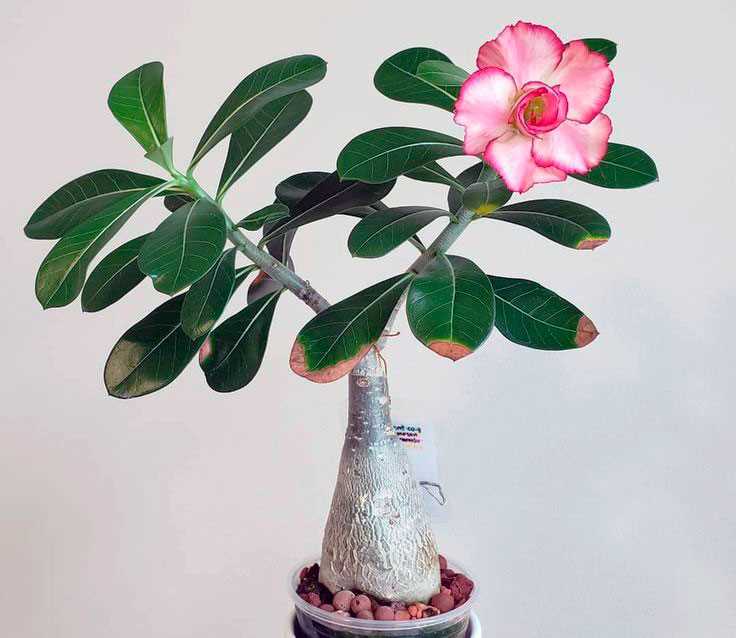
Adenium arabicum is a species of Adenium that is native to the Arabian Peninsula. It is known for its unique caudex, which is the swollen base of the stem that stores water during periods of drought. The flowers of Adenium arabicum are typically white with pink or red markings.
4. Adenium swazicum
Adenium swazicum is a species of Adenium that is native to Swaziland and South Africa. It has a more compact growth habit compared to other types of Adenium, making it a popular choice for small gardens or indoor cultivation. The flowers of Adenium swazicum are usually pink or white and have a distinctive trumpet-like shape.
5. Adenium socotranum
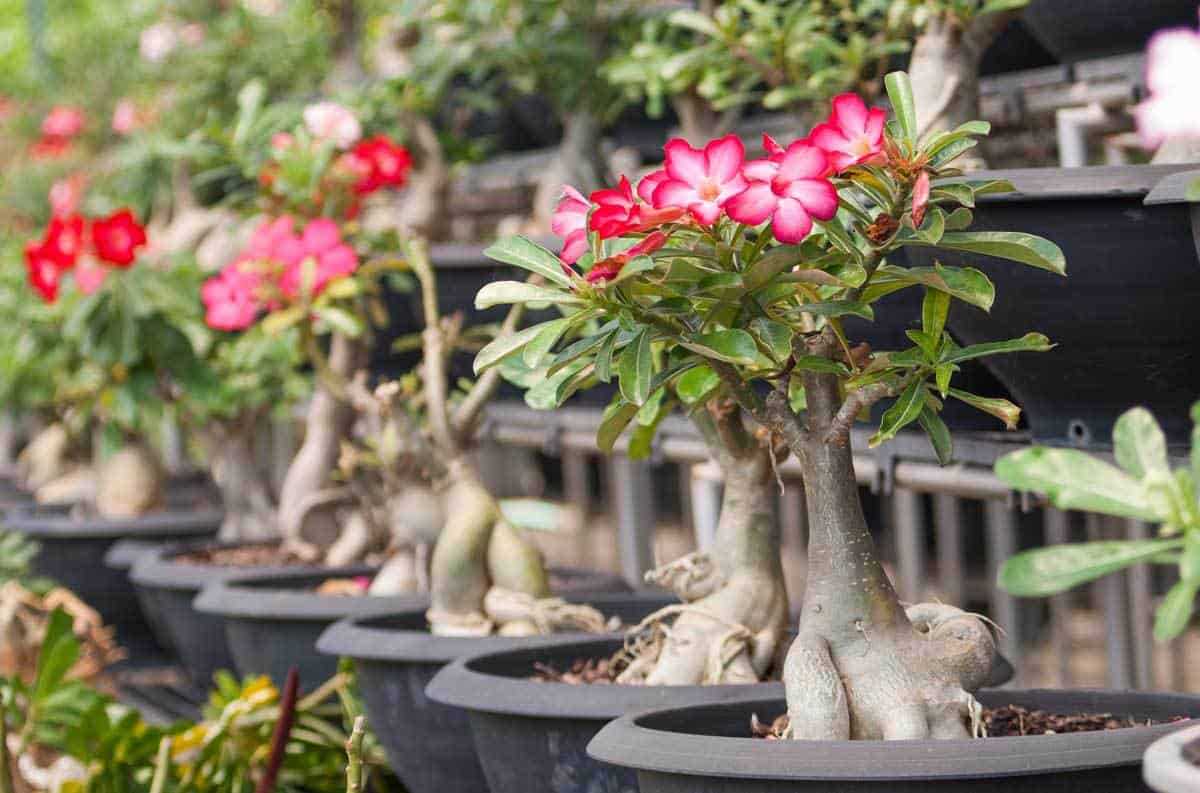
Adenium socotranum is a rare and highly sought-after variety of Adenium that is native to the island of Socotra, off the coast of Yemen. It is known for its massive size and unique appearance, with large, thick stems and bright pink flowers. Adenium socotranum is considered one of the most impressive and beautiful types of Adenium.
| Type | Origin | Characteristics |
|---|---|---|
| Adenium obesum | East Africa | Thick stems, various flower colors |
| Adenium somalense | East Africa | Smaller and bushier growth habit, delicate flowers |
| Adenium arabicum | Arabian Peninsula | Unique caudex, white flowers with pink/red markings |
| Adenium swazicum | Swaziland, South Africa | Compact growth habit, pink/white trumpet-like flowers |
| Adenium socotranum | Socotra Island, Yemen | Massive size, bright pink flowers |
These are just a few examples of the different types of Adenium plants that are available. Each type has its own unique beauty and care requirements, so be sure to choose the right one for your specific climate and preferences. No matter which type you choose, Adenium plants are sure to add a touch of elegance and beauty to any garden or indoor space.
Mastering Adenium Care: The Complete Guide
1. Understanding Adenium
Adenium, also known as Desert Rose, is a popular tropical succulent plant that is native to Africa and the Arabian Peninsula. It is known for its stunning flowers, unique caudex (swollen stem), and ability to thrive in hot and dry conditions.
2. Light Requirements
Adenium plants need plenty of bright, indirect sunlight to thrive. Place them near a south-facing window or in a location with at least 6-8 hours of sunlight per day. However, be careful not to expose them to direct sunlight, as it can scorch their leaves.
3. Temperature and Humidity
Adenium plants prefer warm temperatures between 65-85°F (18-29°C) during the day and slightly cooler temperatures at night. They are not tolerant of frost and should be brought indoors if the temperature drops below 50°F (10°C).
In terms of humidity, Adenium plants can tolerate low humidity levels, but they will benefit from occasional misting to increase the moisture around their leaves.
4. Watering
Proper watering is crucial for Adenium plants. It’s important to let the soil dry out between waterings to prevent root rot. Water the plant thoroughly and allow excess water to drain away. Be careful not to overwater, as this can lead to root rot.
5. Soil and Potting
Adenium plants prefer well-draining soil that is specifically formulated for succulents or cacti. A mixture of sand, perlite, and peat moss works well. When potting, choose a pot with drainage holes to ensure excess water can escape.
6. Fertilizing
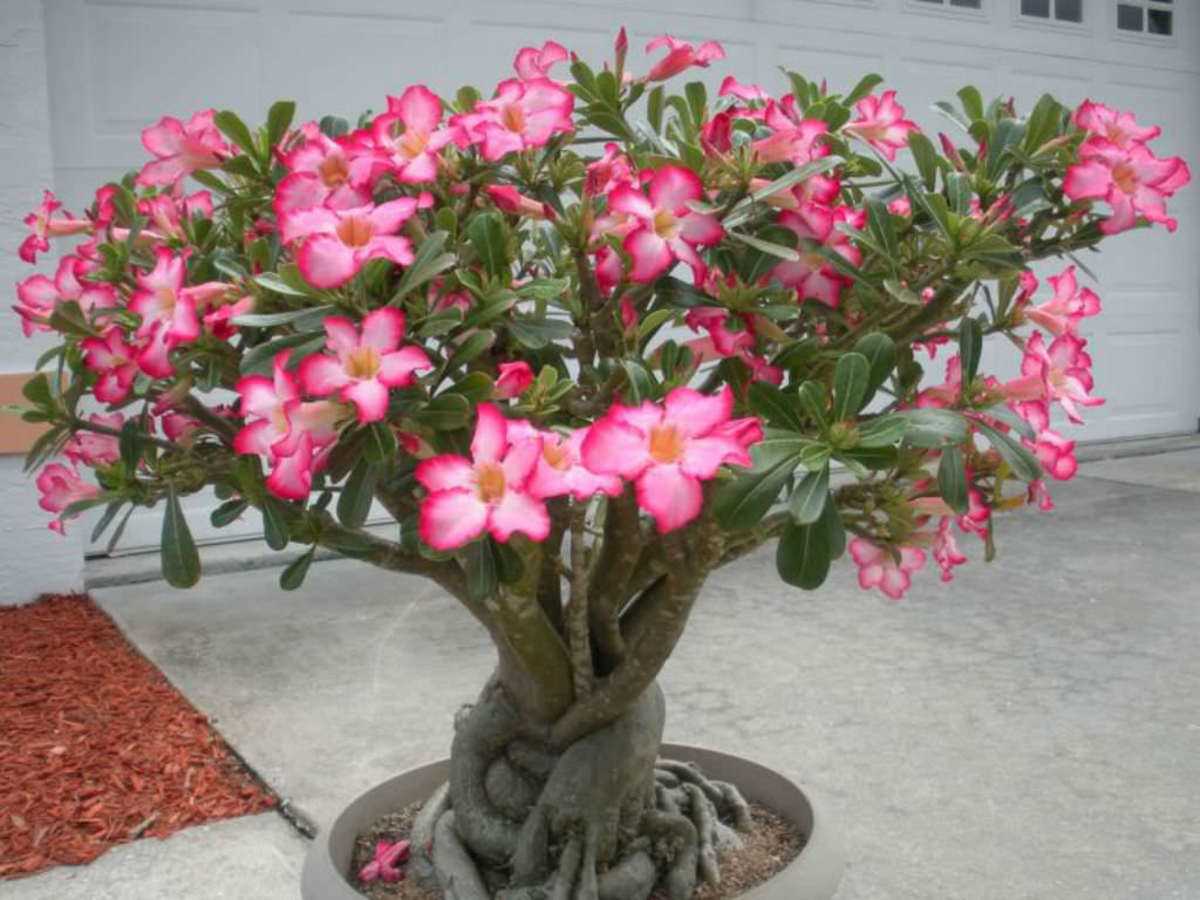
Adenium plants benefit from regular fertilizing during the growing season. Use a balanced fertilizer diluted to half-strength and apply it every 4-6 weeks. Avoid fertilizing during the dormant period.
7. Pruning
Pruning is important to maintain the shape and size of Adenium plants. It’s best to prune during the active growing season. Remove any dead or diseased branches and shape the plant as desired. Use clean pruning shears to prevent the spread of diseases.
8. Pests and Diseases
Adenium plants are generally resistant to pests and diseases. However, they can occasionally be affected by mealybugs, spider mites, and scale insects. Keep an eye out for any signs of infestation and treat them accordingly using organic pest control methods.
9. Propagation
Adenium plants can be propagated through seeds, stem cuttings, or grafting. Seeds require a specialized germination process, while stem cuttings and grafting offer quicker and more reliable results. Follow proper techniques and choose the method that suits your needs and preferences.
10. Common Adenium Varieties
| Variety | Description |
|---|---|
| Adenium obesum | The most common variety with colorful flowers and a distinct caudex. |
| Adenium arabicum | A wild species with smaller flowers and a pronounced caudex. |
| Adenium somalense | An unusual variety with elongated leaves and a unique caudex. |
| Adenium crispum | A rare variety with crinkled leaves and pale pink flowers. |
Conclusion
With the right care and attention, Adenium plants can thrive and reward you with their stunning flowers and unique features. By following the guidelines in this complete guide, you can become a master in Adenium care and enjoy the beauty of these remarkable plants.
Q&A
What is Adenium?
Adenium, also known as Desert Rose, is a flowering plant native to East Africa and the Arabian Peninsula. It is a popular houseplant and is admired for its striking flowers and unique caudex, or swollen trunk.
How do I care for Adenium plants?
Caring for Adenium plants involves providing them with plenty of sunlight, warm temperatures, well-draining soil, and regular watering. They should also be protected from frost and overwatering, as they are adapted to arid conditions.
What are the different types of Adenium?
There are several different types of Adenium, including Adenium obesum, Adenium arabicum, and Adenium somalense. Each type has its own unique characteristics and flower colors.
Can Adenium plants be grown from seeds?
Yes, Adenium plants can be grown from seeds. However, they can take a long time to germinate and may not always be true to the parent plant. Some gardeners prefer to propagate Adenium plants through cuttings to ensure that they retain their desired traits.
Do Adenium plants require pruning?
Adenium plants do benefit from occasional pruning to maintain their shape and promote bushier growth. Pruning should be done in the spring or summer, and any dead or damaged branches should be removed. It’s important to use clean, sharp pruning tools to prevent the spread of disease.
Are Adenium plants toxic to pets?
Yes, Adenium plants are toxic to pets. They contain toxic compounds that can cause gastrointestinal upset, drooling, and vomiting if ingested. It’s important to keep Adenium plants out of reach of pets and seek veterinary care if ingestion is suspected.
Video
54 Desert Rose (Adenium) Varieties | Desert Rose Flower Types | Adenium Flowers |Plant and Planting







